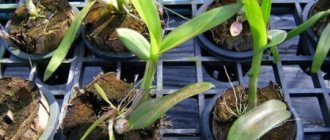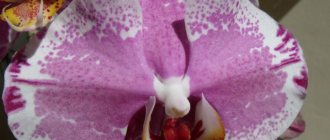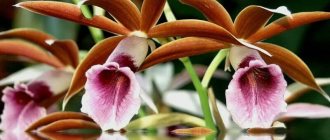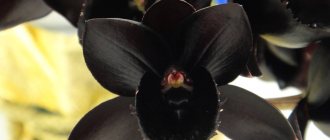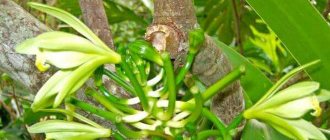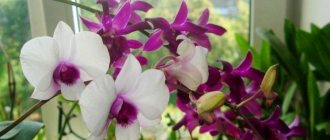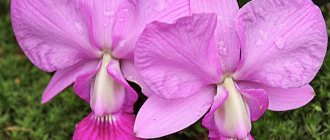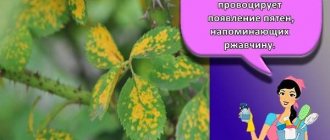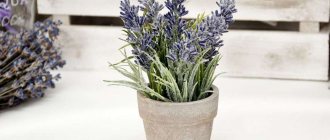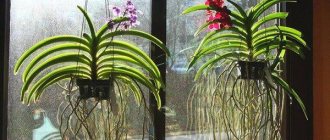Phalaenopsis hybrid
Phalaenopsis is the most common orchid in indoor floriculture. It so happened that in 95% of cases the question “Tell me!” They gave me an orchid, but I don’t know what it’s called,” it turns out that the gift was a phalaenopsis. What determines such love for this particular orchid, and not for dendrobium or, say, ascocende?
"A matter of taste!" - someone will say, and they will be right. Another will add: “It’s easy to grow!” - and he won’t be wrong either. "She's beautiful!" - and this is certain. It turns out that external attractiveness and ease of maintenance determine the popularity of a plant? Exactly!
Although this was not always the case with phalaenopsis. The fact is that until 1995, Russia was supplied mostly with species orchids, that is, natural species taken directly from natural conditions and propagated in open ground or in greenhouses. But the conditions of the premises - apartments, offices, etc. were not suitable for these orchids; there they either did not reveal their decorative potential, that is, they did not bloom or bloomed weakly, or they died very quickly. But after 1995, only hybrid orchids began to go on sale. Why? Because their removal from natural habitats, often barbarically, leads to the threat of species extinction. Hybridization has come to the rescue - the resulting hybrids are propagated in industrial conditions, hybrid orchids bloom no worse than natural species. Moreover, the breeders took care of both the duration of flowering and the fact that orchids could live better in unnatural conditions for themselves.
But you should never forget that when buying a plant, you are acquiring a living organism that requires tireless care! Unfortunately, judging by the number of questions asked on the GreenInfo.ru forum and our telephone service operators, the conclusion is disappointing - people either don’t understand this or are hoping for the eternal Russian “maybe” - maybe it will somehow grow. This is very annoying. With this approach, a person torments the plant and suffers himself, not getting what he expected. What's the end result? - disappointment. To reduce disappointment, let's change our attitude towards plants and feel that we are responsible for those we have tamed.
Let's consider the main points of caring for phalaenopsis, adhering to which you can enjoy the lush green leaves and the stunning beauty of butterfly flowers for a long time.
Phalaenopsis hybrid
Lighting, temperature, spraying
It is best to keep an orchid on an east or west window; you can also keep it in the back of the room under a white fluorescent lamp or under a phytolamp special for plants. Supplemental lighting is especially important in the autumn-winter period; the length of daylight should be at least 14 hours.
The optimal temperature in summer is +20-25°C, in winter +16-18°C. To stimulate flowering, it is important that the orchid experiences a temperature difference of 3-5 degrees between day and night. In winter, at temperatures above +25°C, almost no flowering is observed.
The great adaptability of phalaenopsis to the conditions of detention should be taken into account. Of course, if conditions are created that best match natural requirements, the orchid will live longer and bloom more often.
Leaves should be sprayed with settled water at room temperature regularly, at least 3-5 times a day, especially in winter when the heating system is on, when air humidity is very low.
During the flowering period, you need to spray very carefully, trying not to get it on the flowers - water causes brown spots to appear on the petals, which reduces the decorative effect and leads to the rapid fall of the flowers.
Taxonomy and naming
Genus Phalaenopsis
was first officially described in 1825 by Carl Ludwig Blum and the description was published in
Bijdragen Tot de Flora van Nederlandsch Indië
.[1][7] The name
Phalaenopsis
comes from the Ancient Greek word
falaina
(φαλαινα) meaning "a kind of moth"[8]:535 with the suffix
-opsis
means “having the appearance of” or “similar.”[8]:483[9]
The genus name is abbreviated. Phal.
gardening.[10]
Ornithochilus
Former clan Ornithochilus
has been combined with
Phalaenopsis
and is considered a subgenus by some.
Its members have a distinctly 4-lobed, fringed labella with a short curved spur located towards the middle of the lip rather than at the base. Ornithochilus
previously had three known species, native to China, the Himalayas and Southeast Asia:[11][12]
- Ornithochilus cacharensis
Barbhuya, B. K. Dutta and Squit. — Assam - Ornithochilus difformis
(Wall. Ex Lindl.) Schltr. — Guangdong, Guangxi, Sichuan, Yunnan, Assam, India, Bhutan, Nepal, Myanmar, Thailand, Vietnam, Laos, Borneo, Sumatra, Peninsular Malaysia - Ornithochilus yingjiangensis
Z.H.Qi – Yunnan
Transfer
Phalaenopsis hybrid
The orchid needs to change the substrate as the bark deteriorates and the substrate becomes denser. This is usually done once every 3-4 years. Special substrates “For orchids” are used. It is better to replant in the spring, when growth processes are activated and the orchid tolerates post-transplant stress more easily. The plant survives transplantation worse in the autumn-winter period and recovers more slowly. Do not replant during flowering, otherwise it will end faster.
For phalaenopsis, transparent plastic pots are a more suitable container - the roots of this orchid photosynthesize in the same way as the leaves, that is, the roots need light. When replanting, remove dry, empty, dead roots and old substrate. Very carefully separate the roots that have stuck to the walls of the pot (to do this, an hour before replanting, you need to water, thoroughly moistening the substrate and roots, then they are separated from the walls of the pot more easily). Pieces of bark to which roots have stuck do not need to be removed.
After replanting for two months, it is useful to add Zircon to the irrigation water once every 2 weeks at the rate of 2-3 drops per glass of water - this will help the orchid to take root faster. Any transplant usually delays flowering by 1.5-2 months. There are cases when an orchid blooms immediately after transplantation - stress from damage to the roots affects plants in different ways.
Read more about transplanting in the article Your favorite homemade Phalaenopsis
Description
Orchids in the genus Phalaenopsis
monopodial epiphytic, sometimes lithophytic, herbs with long, coarse roots and short leafy stems hidden by overlapping leaf bases. The leaves are usually arranged in two rows, relatively large and leathery, oblong to elliptical, sometimes succulent. A few to many, small to large, persistent, flat, often fragrant flowers ranging from erect to pendulous. brushes or whisks. The sepals and petals are free and widely spaced from each other. The lateral sepals are usually larger than the dorsal sepals and the petals are much wider than the sepals. The labellum is rigidly connected to the column and has three lobes. The lateral lobes are straight and more or less parallel to each other, and the middle lobe sometimes has a pair of appendages or antennae.[2][3][4][5][6]
Watering
Phalaenopsis hybrid
Orchids are watered in two ways - from a watering can through the top of the pot or by immersion in a container of water.
During the flowering period, it is better to water from a watering can so as not to change the location of the plant, which can cause it to drop flowers. Watering must be carried out in such a way that the substrate and roots dry out once a week. If you keep the roots in a constantly damp or wet substrate, the risk of root rot increases, and the substrate breaks down faster.
When phalaenopsis does not bloom, it is best to water it using the immersion method - the pot is immersed in a bucket of water for 1-2 minutes (until air bubbles stop running). After such submersible watering, you need to let the excess water drain, and only after that return the orchid to its place.
The temperature of the irrigation water should be equal to the air temperature, or even better if the water is 3-4 degrees warmer than the air. The maximum water temperature is +28°C (warmer water burns and scalds the roots). The water must be allowed to stand for 24 hours and be soft.
If the water is still hard (it contains a lot of lime salts, as can be seen from the white stains on the leaves after spraying and the whitish-yellow coating on the surface of the substrate after watering), then the amount of lime in it needs to be reduced.
To do this you can:
- Boil the water for 20 minutes, and take it from a hot tap (it contains less lime than cold water, because it has already boiled at least once);
- Freeze in a plastic bottle, then cut off the bottom and drain the unfrozen water and salts;
- Add oxalic acid to 1 liter of water (at the tip of a knife). After this, the water should stand for 2-4 days until a white precipitate of salts appears at the bottom.
Reproduction of phalaenopsis at home
Orchid propagation by children.
The phalaenopsis orchid reproduces only by children (shoots) and seeds.
At home, the plant is propagated by lateral shoots, shoots that are cut off at the base. A shoot suitable for separation must have 2 leaf blades and aerial roots at least 50 mm long. The propagation procedure is carried out only after the phalaenopsis has flowered. It is very important to separate such young orchids in time, since when the baby begins to outgrow, it begins to interfere with the parent plant, which affects its condition.
After separation, the baby is dried for a day, then planted in standard soil for orchids and covered with a greenhouse. Regular room temperature is suitable for rooting.
Phalaenopsis hieroglyphica. ©snotch
Orchid propagation by peduncle
After the phalaenopsis has faded, the peduncle must be cut off at the base and placed in water with the addition of mineral fertilizer. The peduncle is immersed in water to a depth of 70 mm. The scales are removed from the kidneys. The peduncle must be covered with a bag, which will create greenhouse conditions. Place the container with flower stalks in a well-lit place and change the water regularly.
Phalaenopsis gigantea. ©Orchi
Stimulating the formation of phalaenopsis orchid babies
If an orchid does not produce babies for a long time, it can be stimulated. To do this, you need to find a bud at the base of the faded peduncle. Using a blade or a sharp knife, a not very deep incision is made at the base of the scale, after which the kidney is treated with a growth stimulator. The formation of a baby takes 1-2 months, and after 3 months it will form roots. In order to speed up this process, the baby can be placed under a greenhouse and covered with a bag.
Phalaenopsis equestris. ©Maja Dumat
Top dressing
Phalaenopsis hybrid
Fertilizers are used specialized, “For orchids”.
Fertilizing during the flowering period in summer is carried out 2-3 times a month, during the flowering period in autumn and winter they are fed 2-3 or 1-2 times a month, but the concentration of the fertilizer is reduced by half from that indicated in the instructions.
During the period of absence of flowering, you can not feed or feed once a month, not more often.
To remove excess salts, rinse the soil under running warm water for 15-20 minutes once a month.
Variety
The following is a list of Phalaenopsis
species accepted by the World Checklist of Selected Plant Families as of January 2022:
| Image | Name | Distribution | Height (m) |
| Phalaenopsis amabilis (L.) Bloom 1825 | East Malaysia to Papuasia | 0–600 meters | |
| Phalaenopsis amboinensis J. J. Smith 1911 | Ambon Island, Sulawesi, Papua and New Guinea and Indonesia | ||
| Phalaenopsis aphrodite Rchb.f 1862 | Philippine Islands, Sulu Archipelago and Taiwan, China | ||
| Phalaenopsis appendiculata Carr 1929 | Pahang, Malaysia to northeast Borneo | ||
| Phalaenopsis bastianii O. Gruss, L. Röllke, 1991 | Philippines - Luzon, Sulu Archipelago | ||
| Phalaenopsis bellina Christenson 1995 | Borneo | 200 meters and below | |
| Phalaenopsis braceana (Chorus. E.) Christenson 1986 | Eastern Himalayas, Bhutan, Myanmar, Thailand, Vietnam, China - Yunnan | 1100 - 2100 meters. | |
| Phalaenopsis buyssoniana Rchb. f. 1888 | Indochina, Thailand and Vietnam | ||
| Phalaenopsis cacharensis (Barbhuiya, B.K.Dutta & Schuit.) Kocyan & Schuit. 2014 | India (Cachar, Assam) | ||
| Phalaenopsis Celebensis Sweet 1980 | Sulawesi | ||
| Phalaenopsis chibae T. Yukawa 1996 | Vietnam | 400-600 meters | |
| Phalaenopsis cochlearis Holttum 1964 | Malaysia and Sarawak, Borneo | 450 – 700 meters | |
| Phalaenopsis corningiana Rchb. f. 1879 | Borneo | 450 – 610 meters | |
| Phalaenopsis cornu-cervi (Breda) Blume & Rchb.f. 1860 | India, Myanamar, Thailand, Laos, Vietnam, Nicobar Islands, Malaysia, Java, Borneo, Sumatra and the Philippines. | 1000 meters and below | |
| Phalaenopsis deliciosa Rchb. f. 1854 | From India to Southeast Asia, Java, Sumatra, Borneo and the Philippines | 600 meters and below | |
| Phalaenopsis difformis (Wall. Ex Lindl.) Kocyan & Schuit. 2014 | Assam India, eastern Himalayas, Nepal, western Himalayas, Myanmar, Thailand, Malaysia, Laos, central and southern China, Vietnam, Borneo and Sumatra | 300 – 1600 meters | |
| Phalaenopsis doweryënsis Garay & Christenson 2001 | Sabah | 150 meters | |
| Phalaenopsis equine [Schauer] Rchb.f 1849 | Taiwan - Xiao Lan Yu to the Philippines | 0 - 300 meters. | |
| Phalaenopsis fasciata Rchb.f 1882 | Philippines | ||
| Phalaenopsis fimbriata JJ See 1921 | Java, Sumatra and Sarawak | 790 - 1300 meters. | |
| Phalaenopsis finleyi Christenson 2011 | Thailand and Burma | ||
| Phalaenopsis floresensis Foley 1993 | Flores island in Indonesia | 150 – 500 meters | |
| Phalaenopsis fuscata Rchb. f. 1874 | Sumatra, Peninsula Malaysia, Borneo, Philippines - Palawan Island | 0 - 1000 meters | |
| Phalaenopsis gibbosa H. R. Sweet 1970 | Laos and northern Vietnam | 0 - 1000 meters | |
| Phalaenopsis giant J. J. Smith 1909 | Sabah, Borneo, Java and Sarawak | 0 - 400 meters | |
| Phalaenopsis hieroglyphica [Rchb.f] Sweet 1969 | Philippines - Luzon, Leyte, Samar, Palawan and Mindanao islands | ||
| Phalaenopsis honghenensis FY Liu 1991 | China - Yunnan | 2000 meters | |
| Phalaenopsis inscriptiosinensis Foley 1983 | Central Sumatra | 914 meters and below | |
| Phalaenopsis japonica (Rchb.f.) Kocyan & Schuit. 2014 | Z. Yunnan, Zhejiang, Japan (southern regions of the Ryukyu Islands), Korea (Jollanam-do). | 600 – 1400 meters | |
| Phalaenopsis javanica JJSm. 1918 | West Java | ||
| Phalaenopsis kapuasensis Methusala and P. O'Byrne 2017 | Kapuas Hulu, West Kalimantan Province, Indonesia | 50-200 meters | |
| Phalaenopsis kunstleri Hook. f. 1890 | From Myanmar to Malaysia | ||
| Phalaenopsis lindenii Loer 1895 | Philippines - Luzon Island | 1000-1500 meters | |
| Phalaenopsis lobbii (Rchb. F.) HR Sweet 1980 | Himalayas, northeast India, Bhutan, Sikkim, Myanamar and Vietnam | 366 – 1200 meters | |
| Phalaenopsis low Rchb.f 1862 | Myanamar, Thailand and Borneo | 800 meters. | |
| Phalaenopsis lueddemanniana Rchb.f 1862 | Philippines | below 100 meters. | |
| Phalaenopsis luteola (Burb. Ex Garay) Christenson & O. Gruss 2001 | North West Borneo | ||
| Phalaenopsis maculata Rchb.f 1881 | From Malaya to Borneo and Sulawesi | 0 - 1000 meters | |
| Phalaenopsis malipoensis Z. J. Liu and S. K. Chen 2005 | China - Yunnan | ||
| Phalaenopsis mannii Rchb.f 1871 | Indian Himalayas, Assam, Nepal, Bhutan, Sikkim, Myanmar, southern China and Vietnam | 500-1500 meters | |
| Phalaenopsis mariae Burbidge ex Warner & Williams 1883 | Northeast Borneo to Philippines-Mindanao | 600 meters | |
| Phalaenopsis marriottiana (Rchb.f.) Kocyan & Schuit. 2014 | Guangxi, China and Myanmar | ||
| Phalaenopsis mentawaiensis O. Gruss 2014 | Mentawai Islands of Sumatra | ||
| Phalaenopsis micholitzii Rchb. f. 1874 | Philippines - Mindanao Island | 400 meters | |
| Phalaenopsis mirabilis (Seidenf.) Schuit. 2007 | Thailand. | ||
| Phalaenopsis modesta JJ See 1906 | Borneo | 50 – 900 meters | |
| Phalaenopsis mysorensis C. J. Saldana 1974 | Mysore, India. | ||
| Phalaenopsis natmataungensis (T. Yukawa, Nob Tanaka and J. Murata) Dahlström and Ormerod, 2010 | Myanmar | 1700 - 1950 meters | |
| Phalaenopsis pallens [Lindley] Rchb.f 1864 | Philippines - Luzon and Mindanao islands | 500 meters | |
| Phalaenopsis pantherina Rchb. f. 1864 | Borneo | 0 - 800 meters. | |
| Phalaenopsis parishii Rchb. f. 1865 | eastern Himalayas, Assam, India, Myanmar, Thailand and Vietnam | below 500 meters | |
| Phalaenopsis philippinensis Golamco ex Fowlie & CZ Tang 1987 | Philippines - Luzon Island | up to 1200 meters | |
| Phalaenopsis pulcherrima (Lindl.) JJSm. 1933 | Assam India, Myanmar, Thailand, Malaysia, Laos, Cambodia, Yunnan and Xizang China, Vietnam, Borneo and Sumatra | ||
| Phalaenopsis pulchra (Rchb. F.) H. R. Sweet 1968 | Philippines - Luzon Island | 100 – 650 meters | |
| Phalaenopsis reichenbachiana Rchb.f. And Sander 1882 | Philippines - Mindanao Island | ||
| Phalaenopsis robinsonii JJSm. 1917 | Ambon, Maluku. Moluccas Islands | ||
| Phalaenopsis rundumensis P.J. Cribb and A.L. Lamb [2012] 2011 | Sabah | ||
| Phalaenopsis sanderiana Rchb. f. 1883 | Philippines - Mindanao Island | ||
| Phalaenopsis schilleriana Rchb.f 1860 | Philippines - Luzon, Mindoro and Biliran islands | 0 - 450 meters | |
| Phalaenopsis stobartiana Rchb. f. 1877 | China - southeastern Tibet in Guangxi | ||
| Phalaenopsis stuartiana Rchb.f. 1881 | Philippines - Mindanao Island | below 300 meters | |
| Phalaenopsis subparishii (Z. H. Qi) Kocyan & Schuit. 2014 | N Fujian, N Guangdong, NE Guizhou, SW Hubei, Hunan, NE Sichuan, Zhejiang. | 300 – 1100 meters | |
| Phalaenopsis sumatrana Korth. & Rchb. f. 1860 | Indochina, from Borneo to the Philippines - Palawan Island | 700 meters | |
| Phalaenopsis taenialis [Lindl.] E.A. Christ. And Pradham 1986 | Himalayas, Assam India, Nepal, Bhutan, Sikkim, Myanmar, to China - Yunnan | 1000 - 2500 meters | |
| Phalaenopsis tetraspis Rchb.f. 1868 | Andaman and Nicobar Islands to northwest Sumatra | 0 meters. | |
| Phalaenopsis thailand O. Gruss and Ret 2009 | Thailand | ||
| Phalaenopsis qi (MHLi, ZJLiu and SRLan) Hua Deng, ZJ Liu and Yang Wang, 2015 | China (Hunan) | 1200 - 1850 meters | |
| Phalaenopsis ubonensis (O. Gruss) J.M.H. Shaw 2014 | Thailand and Laos | ||
| Phalaenopsis venosa Shim & Foley, 1983 | Celebes Islands, Sulawesi | 914 meters. | |
| Phalaenopsis violacea Witte 1861 | From Malaya to Sumatra | 150 meters. | |
| Phalaenopsis viridis JJ Sm 1907 | Sumatra | 700 - 1000 meters | |
| Phalaenopsis wilsonii Rolf 1909 | Sichuan, Eastern Tibet, Yunnan and Guangxi, China | 800 – 2200 meters | |
| Phalaenopsis yingjiangensis (Z. H. Qi) Kocyan & Schuit. 2014 | Yunnan, China and India | 1584 meters | |
| Phalaenopsis zhejiangensis (Z.H.Qi) Schuit. 2012 | Zhejiang China | 300 – 900 meters |
History of origin
The first mentions of this culture contain Chinese chronicles compiled 2500 BC, and the first flower was found in the distant 18th century by a traveler from Germany Georg Rimpfius , traveling through the Moluccas.
But the plant appeared in the first botanical reference book only in 1752, when another German naturalist, Carl Linnaeus, came into possession of a herbarium containing several carefully dried specimens of an outlandish flower. He gave it the first name Epidendrum amabilis - “living on a tree.”
Almost seven decades later, Blume, director of the botanical garden of Leiden, discovered several more specimens in the Malay Archipelago, and gave them another name Phalaenopsis - from the Greek words “Phalania” (night butterfly) and “Opsis” (resemblance).
The plant appeared in European botanical gardens at the beginning of the 19th century . The price for each specimen reached sky-high heights, and only monarchs could afford to purchase phalaenopsis for their personal collections.
In the 20th century, scientist-enthusiasts Knudson and More, independently of each other, developed the first hybrid, which easily crossed with other orchids. Anyone could now breed the variety. Hundreds of books have been written where you can read everything about it - the beautiful phalaenopsis, how to grow it yourself at home, how to replant and propagate.
Species diversity
The Phalaenopsis orchid genus has more than 70 species. They differ in size and color of flowers and leaves. The conditions for keeping all species are the same.
Phalaenopsis amabilis
In terms of size, this type of phalaenopsis is average. Its dark green leaves reach 50 cm in length, the diameter of the flowers is 10 cm. It can bloom twice a year, invariably with white flowers with a yellow or purple lip. At the same time, 15 to 100 flowers bloom on the peduncle. They open sequentially and stay on the plant for several months.
Schiller's Phalaenopsis (Phalaenopsis chilleriana)
This view is similar to the previous one. The main difference is the color of the leaves: they are reddish below and gray with dark green spots on top. There are legends about the flowering of Schiller's phalaenopsis. And not out of nowhere: it is really capable of blooming flowers several times a year, releasing several flower stalks at the same time; up to 150 buds can fit on a flower at the same time.
Phalaenopsis Stuartiana
It differs from other species in its peduncle, which can branch, as well as in the bizarre coloring of its flowers. Their petals are white, with small spots at the base, and the lip is “ornate”, golden yellow with bright purple spots. Stewart's phalaenopsis prefers to bloom in autumn and spring.
Phalaenopsis lueddemanniana
This species is compact in size. The light green leaves grow no more than 25 cm long. The flowers are also small, up to 7 cm in diameter. They are painted in all sorts of shades of pink and purple. There are usually no more than 7 of them on a peduncle. But an adult healthy Luddeman’s phalaenopsis can bloom almost all year round. Its buds exude a delicate aroma.
Giant Phalaenopsis (Phalaenopsis gigantea)
This species got its name for a reason. The size is truly impressive: the leaves can grow up to 1 meter in length. Peduncle – up to 40 cm. It can accommodate up to 10 buds. On an adult healthy plant, several flower stalks usually appear at once, so that up to hundreds of flowers can bloom on the plant at the same time.
That's all for the views. Let's move on to the flowering of the plant.

